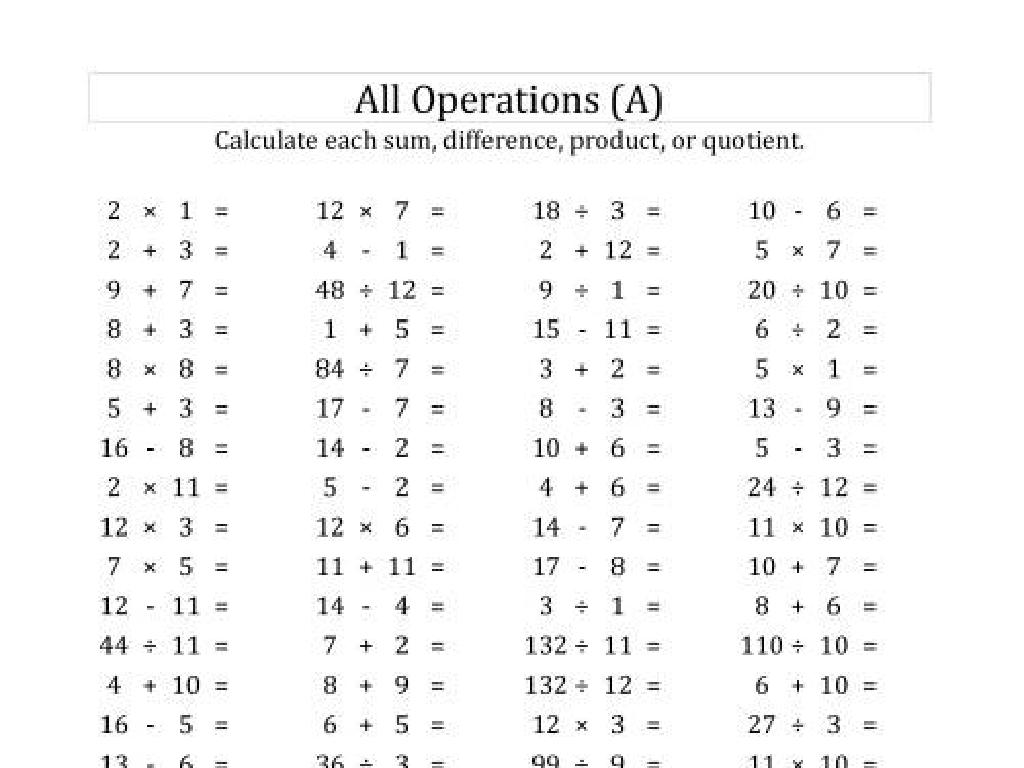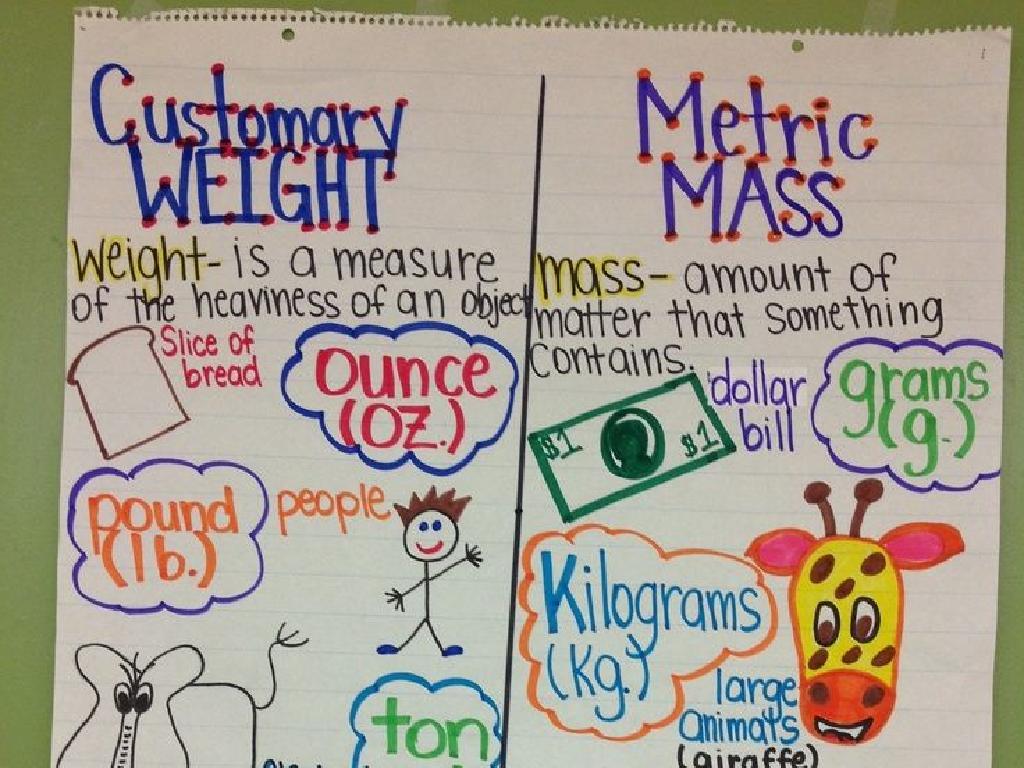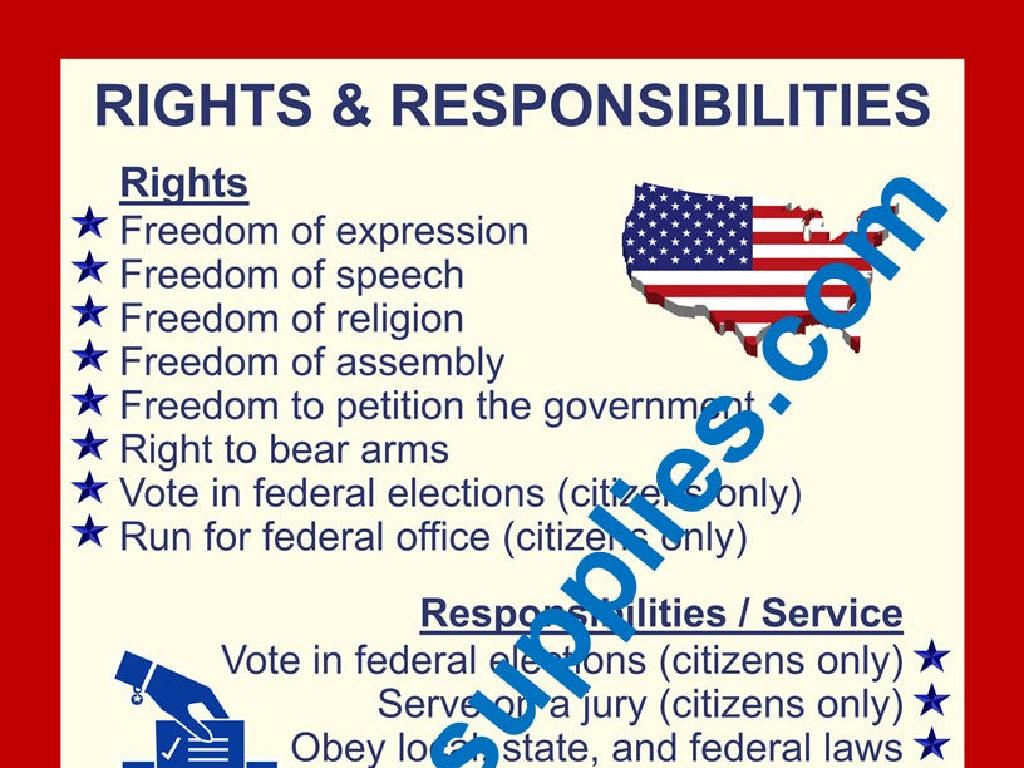Identify And Correct Errors With Plural And Possessive Nouns
Subject: Language arts
Grade: Seventh grade
Topic: Nouns
Please LOG IN to download the presentation. Access is available to registered users only.
View More Content
Mastering Plural and Possessive Nouns
– Plural nouns: More than one
– Plurals often end in ‘s’ or ‘es’, e.g., ‘dogs’, ‘watches’
– Possessive nouns: Ownership
– Formed by adding ‘s or s’, e.g., ‘dog’s bone’, ‘students’ books’
– Spotting the difference is crucial
– Correcting common noun errors
– We’ll practice fixing sentences with noun mistakes
|
This slide introduces the concept of plural and possessive nouns, which are fundamental in English grammar. Plural nouns indicate more than one of something and usually end in ‘s’ or ‘es’. Possessive nouns show ownership and are formed by adding ‘s or just an apostrophe for plural nouns ending in ‘s’. Understanding the difference between these two types of nouns is essential for students to master English grammar. The class will involve interactive activities to help students identify and correct errors in the usage of plural and possessive nouns. Prepare examples of common mistakes and exercises for students to practice.
Exploring Nouns: Plurals and Possessives
– Define a noun: person, place, thing, or idea
– Examples: ‘cat’, ‘school’, ‘book’, ‘freedom’
– Categorizing nouns activity
– We’ll sort nouns into groups and discuss
– Plural vs. possessive nouns
– Plurals add ‘s’ or ‘es’, possessives show ownership with an apostrophe
|
Begin with a quick review of what a noun is, providing clear examples. Then, engage the class in an interactive activity where they categorize nouns into people, places, things, or ideas. This will help reinforce their understanding of nouns in a fun and collaborative way. Afterward, introduce the concept of plural and possessive nouns, highlighting the differences in their formation and usage. Plural nouns indicate more than one, while possessive nouns show ownership. Use examples like ‘cats’ for plural and ‘cat’s’ for possessive to illustrate the point. Encourage students to come up with their own examples and correct common mistakes. This will prepare them for identifying and correcting errors in their writing.
Singular vs. Plural Nouns
– Singular nouns: one item
– Example: ‘dog’ signifies a single canine
– Plural nouns: more than one
– Example: ‘dogs’ signifies multiple canines
– ‘s’ or ‘es’ for regular plurals
– Most plurals end with ‘s’ like ‘cats’ or ‘es’ like ‘boxes’
– Beware of irregular plurals
– Irregulars don’t follow rules, like ‘mouse’ to ‘mice’
|
This slide introduces the concept of singular and plural nouns to the students. Singular nouns denote one single item, while plural nouns are used when there is more than one of the same item. The general rule for creating plurals is to add ‘s’ or ‘es’ to the end of the singular noun. However, it’s crucial to highlight the irregular plural forms that do not follow this rule. Provide examples of both regular and irregular plurals, and encourage students to come up with their own examples. Have them write sentences using both singular and plural forms to practice identifying and correcting errors.
Making Nouns Plural
– Add ‘s’ to make most nouns plural
– Singular: ‘dog’, Plural: ‘dogs’
– Use ‘es’ for nouns ending in s, x, z, ch, sh
– Singular: ‘fox’, Plural: ‘foxes’
– Practice with class examples
– We’ll work through examples as a class
– Understand exceptions to the rules
– Some nouns don’t follow these rules
|
This slide introduces the basic rules for making nouns plural, which is a key concept in understanding noun usage. Start by explaining that most nouns become plural by simply adding an ‘s’. Then, discuss the second rule where nouns ending in s, x, z, ch, sh require ‘es’ to become plural. Provide clear examples for each rule to ensure understanding. During class, engage students with practice examples to apply these rules. Highlight that there are exceptions to these rules, which will be covered in future lessons. Encourage students to think of their own examples and share them with the class.
Irregular Plural Nouns
– Nouns with unique plural forms
– ‘Child’ becomes ‘children’, not ‘childs’
– Memorization of irregular plurals
– Words like ‘mouse’ to ‘mice’ need to be remembered
– Identifying irregular plurals
– Think of words that don’t add ‘s’ or ‘es’ for plural
– Practice with examples
– Use words like ‘foot’ to ‘feet’ in sentences
|
This slide focuses on irregular plural nouns, which are nouns that do not follow the standard rules for making plurals by simply adding ‘s’ or ‘es’. Students should understand that these nouns must be memorized because they don’t have a predictable pattern. Provide examples like ‘man’ to ‘men’, ‘tooth’ to ‘teeth’, and ‘goose’ to ‘geese’. Encourage students to come up with their own examples and write sentences using them. This will help reinforce their understanding and ability to use these nouns correctly. During the next class, review these examples and correct any misconceptions.
Mastering Possessive Nouns
– Understanding possessive nouns
– Possessive nouns indicate ownership, like ‘the dog’s leash’.
– Singular nouns: add ‘s
– For one girl, it’s ‘the girl’s book’.
– Plural nouns: add ‘
– For many girls, it’s ‘the girls’ book’.
– Showing ownership effectively
|
This slide aims to clarify the concept of possessive nouns for students, which are used to show ownership or belonging. Emphasize that for singular nouns not ending in ‘s’, we add an ‘s to make them possessive. For plural nouns already ending in ‘s’, we simply add an apostrophe at the end. Provide examples for both cases and encourage students to create sentences using possessive nouns from their surroundings, like ‘the teacher’s desk’ or ‘the students’ classroom’. This will help them understand how to form possessive nouns and use them correctly in writing.
Mastering Its vs. It’s
– ‘It’s’ is a contraction for ‘it is’ or ‘it has’
– ‘Its’ shows possession by ‘it’
– Correcting ‘its’ and ‘it’s’ in sentences
– Let’s identify and fix mistakes in given sentences.
– Practice with examples
– Example: ‘It’s going to rain.’ vs. ‘The frog jumped off its leaf.’
|
This slide aims to clarify the common confusion between ‘its’ and ‘it’s’. ‘It’s’ is used when we can replace it with ‘it is’ or ‘it has’, while ‘its’ is used to show possession, similar to ‘his’ or ‘her’. Students will practice identifying and correcting sentences that misuse ‘its’ and ‘it’s’. Provide sentences with both correct and incorrect usage and ask students to correct them. This exercise will help reinforce their understanding of the difference between these two forms. Encourage students to explain why they made each correction to ensure comprehension.
Practice Time: Plural & Possessive Nouns
– Identify plural & possessive nouns
– Look for nouns ending in ‘s’, ‘es’, or apostrophe
– Correct errors in sentences
– Change incorrect noun forms to correct ones
– Pair up for discussion
– Explain your reasoning to your partner
– Share corrections with class
|
This slide is for a class activity focused on identifying and correcting errors with plural and possessive nouns. Students should first look for nouns that are in plural form (ending in ‘s’ or ‘es’) and possessive form (with an apostrophe). They will then correct any errors they find in the provided sentences. After making corrections, students will work in pairs to discuss their answers, explaining their reasoning and understanding of the rules. This peer interaction will help reinforce their learning. Finally, they will share their corrections with the class, allowing for a group discussion and further clarification from the teacher. The teacher should prepare sentences with common errors and ensure that each pair has a different set of sentences to maximize learning opportunities.
Class Activity: Noun Hunt
– Find classroom items for noun forms
– Write plural and possessive forms
– E.g., ‘desk’ becomes ‘desks’ (plural), ‘desk s’ (possessive)
– Share findings with the class
– Create a story using the nouns
– Use the nouns to craft an engaging story
|
This interactive activity is designed to help students understand the difference between plural and possessive nouns through practical application. Have students look around the classroom and select various items. Then, they should write down the plural form (adding ‘s’ or ‘es’, or changing ‘y’ to ‘ies’) and the possessive form (adding ‘s or just an apostrophe for plural nouns ending in ‘s’). Afterward, students will share their findings with the class to ensure understanding and correct any misconceptions. Finally, they will use the nouns they have found to create a short story, which will help them apply their knowledge creatively. For the teacher: Prepare a list of items in case some students struggle to find nouns. Be ready to explain exceptions to the rules for pluralization and possession. Encourage creativity and fun in the story-making process.
Wrapping Up: Plural & Possessive Nouns
– Excellent work with nouns today
– Homework: 10 sentences with plurals & possessives
– Include both plural nouns (e.g., dogs, buses) and possessive nouns (e.g., dog’s leash, bus’s route)
– Focus on correct noun forms
– Ensure singular possessives end with ‘s and plurals without ‘s (e.g., the dogs’ bones)
– Share your sentences next class
|
Today’s lesson focused on identifying and correcting errors with plural and possessive nouns. For homework, students are tasked with writing 10 original sentences that correctly use plural and possessive nouns. This exercise will reinforce their understanding of how to form plurals and possessives, and how context determines the correct usage. In the next class, students will have the opportunity to share their sentences, allowing them to learn from each other’s examples. Encourage creativity and remind them to review the rules if they are unsure about the correct forms.






